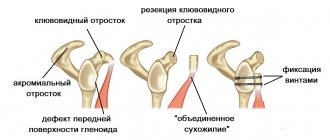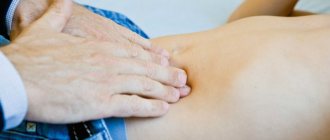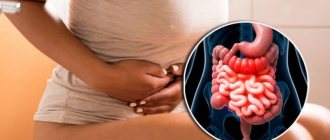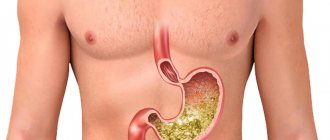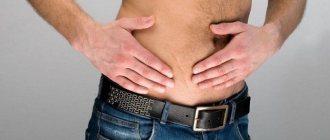General information
Burning sensation, like pain, is an important diagnostic symptom. A burning sensation in the stomach most often occurs in the initial stages of gastritis or peptic ulcer .
The symptom can be relieved with medication, because prolonged burning can lead to cancer. Unregulated loads on the digestive system lead to changes in acidity, disruption of the glandular tissues of the stomach and their integrity. When the “stomach is on fire,” in contrast to heartburn , it does not burn in the upper parts of the larynx (as a result of reflux disease and involuntary reflux of food into the esophagus), but discomfort is felt somewhat lower - in the epigastric region. Despite the different etiologies, their treatment is similar.
Why can't you use soda?
The most famous home remedy for eliminating a burning sensation behind the sternum is baking soda. Alkali neutralizes hydrochloric acid, thereby eliminating the unpleasant symptom. However, it has been proven that the use of this method of treatment only causes harm. In the process of neutralizing the acid, a large amount of carbon dioxide is released, which distends the stomach. This can cause damage to the mucous membrane, and in the presence of an ulcer, even bleeding5. In addition, the environment in the stomach must remain acidic. Therefore, after using soda, the compensatory mechanism for the production of hydrochloric acid starts almost immediately. The result may be even more severe discomfort in the stomach and esophagus5.
Pathogenesis
The burning sensation is accompanied by irritation and injury to the mucous membranes due to increased acidity of gastric juice, peptic enzyme activity and the formation of ulcers. It can “burn with fire” when a person is very hungry and acidic gastric juice reaches erosive areas.
Irritation of the mucous membranes can occur not only due to acidic gastric contents, but in more rare cases it is caused by alkaline reflux . In this case, the mucous membranes are exposed to the action of bile acids , which enter the stomach through the duodenogastric reverse flow of bile.
The pathological process begins with an imbalance in the ratio of “aggressive” and “protective” factors of the digestive system. The main aggressive effect is to increase the activity of proteolytic enzymes and the level of acidity secreted by gastric juice, along with a deterioration in the motility of the digestive organs. Protective properties are reduced if:
- less mucus is produced;
- the processes of natural physiological regeneration of the epithelial surface slow down;
- local blood circulation, innervation and trophism are disrupted.
For example, this can occur under conditions of prolonged or repeated psycho-emotional stress against a background of negative emotions.
A separate predisposing factor, along with heredity and family history, are deficiencies in diet and nutrition, smoking and alcohol abuse.
The pathological process is based on proteolytic destruction of tissue by gastric juice in an area with deteriorated trophism, which is most often observed in the lower parts of the stomach. A decrease in the alkaline component and prolonged contact with acidic gastric juice is possible with spasm of the gastric sphincter - the pylorus. In addition, the level of mucin contained in mucus, the state of the apical membranes of enterocytes, and nervous and vascular trophism are important .
When the mucous barrier and the protein-lipid complex of the apical membranes are destroyed, reverse diffusion of hydrogen ions into the cell membranes occurs, which activates the kinin-kallikrein inflammatory system and increases the permeability of the capillary network. This leads to microcirculation disorder, then lipid peroxidation products as a result of oxidative degradation of lipids under the influence of free radicals, damaging lysosomes.
The negative neuro-emotional effect on the gastrointestinal tract is carried out through the anterior parts of the hypothalamus , along the path of the vagus nerve, acetylcholine, histamine and gastrin receptors in glandular tissues. The formation of acid and the proteolytic activity of the gastric glands increases under the influence of thyroid-stimulating and adrenocorticotropic hormone - the glucocorticoid effect of the adrenal glands increases and the mineralcorticoid effect of the adrenal glands decreases, the production of hydrochloric acid is stimulated and the protective and reparative properties of the mucous membranes of the stomach and intestinal tract are reduced.
Local protective mechanisms are implemented by mucoid cells that produce glycoproteins , sialoproteins and fucopolyproteins , as well as mucus coming from the oral cavity. It is alkaline and can neutralize hydrochloric acid (HCl). In general, the gastrointestinal tract is a very vulnerable system of the body, but it has good regenerative abilities.
Why does heartburn hurt?
The reflux of gastric juice with a food bolus into the esophagus, where normally there should be an alkaline environment, leads to irritation of the mucous membrane. The epithelium of the esophagus does not have a special protective layer from the aggressive effects of acid, which is located in the stomach. Therefore, the mucous membrane is damaged6. Erosion is formed - surface defects that do not affect the muscular layer of the esophagus. These wounds are additionally exposed to acid, which causes pain.
Heartburn is characterized by pain behind the sternum and in the epigastric region. It is quite easy to confuse it with the heart. A specific condition for pain in the esophagus is a direct connection with food intake7. In addition, heartburn and stomach pain worsen when bending over or in a horizontal position.
Classification
Burning in the epigastrium can be constant or occur exclusively after meals.
Constant burning sensation in the stomach
Burning painful sensations at night and in the morning are an alarming sign and a reason to consult a doctor. A constant burning sensation in the stomach and esophagus usually occurs due to pathology - gastritis , peptic ulcer or reflux disease . Most often, discomfort and pain are caused by damage to the tissues lining the digestive tract.
Burning in the stomach after eating
Swelling in the epigastric region (corresponding to the projection of the stomach on the anterior wall of the peritoneum) after eating may be due to poor nutrition. Even a small piece of a harmful or coarse product can irritate nerve endings, provoke inflammation and burning sensations.
How to get rid of heartburn after eating?
To eliminate a burning sensation behind the sternum, the following groups of drugs are used:
- Antacids. Mechanism of action: neutralization of hydrochloric acid. Thus, food, even after entering the esophagus from the stomach, does not irritate it. The drugs give a quick but short-term effect5.
- Alginates. They form a special barrier that prevents acid from irritating the esophagus. They are used for symptomatic therapy and do not affect the mechanisms of heartburn formation1.
- Antisecretory drugs. These include proton pump inhibitors5. They suppress the secretion of acid in the stomach, that is, they act directly on the mechanism of heartburn formation5. One of the representatives of this group is Omez 10 mg with the active ingredient omeprazole6. The drug is taken once a day and is valid for 24 hours4.
People sometimes prefer to cope with symptoms with folk remedies. Baking soda for heartburn after eating is the most common method of combating the burning sensation. It is not recommended to use it. Baking soda neutralizes acid in the esophagus and stomach, so it brings short-term relief. However, a compensation mechanism is triggered in the body, causing acid production to increase. The next heartburn attack will be even worse3. The same applies to milk as an emergency remedy for burning sensations. Among folk remedies, the only safe way to alleviate the condition is to drink a glass of clean still water.
Heartburn does not always indicate the presence of a disease. The symptom can occur even in healthy people. But don't ignore the burning sensation that impairs your daily life. Follow the recommendations and you can forget about this condition for a long time.
Bibliography:
- Tytgat GN, McColl K., Tack J. et al. New algorithm for the treatment of gastroesophageal reflux disease // Aliment. Ther. – 2008. – Vol. 27. – P. 249–256.
- Belmer S.V. Gastroesophageal reflux disease // Russian Medical Journal. – 2008. – No. 3. – P. 144-148.
- Ivashkin V.T. Gastroenterology: Clinical guidelines / Ed. V.T. Ivashkina. 2nd ed., rev. and additional – M.: GEOTAR-Media, 2009. – 208 p.
- INSTRUCTIONS for the use of the medicinal product for medical use OMEZ10 mg LP 00328 dated 07/11/17 Date of access 11/26/18
- Minushkin O.N., Maslovsky L.V., Loshchinina Yu.N., Anikina N.Yu. Omeprazole in the treatment of patients with gastroesophageal reflux disease // Effective pharmacotherapy in gastroenterology. – 2009. – No. 1, pp. 20-26.
- Ivashkin V.T., Maev I.V., Trukhmanov A.S. and others. Gastroesophageal reflux disease. Clinical recommendations // Russian Gastroenterological Association. M., 2014. 23 p. .
Causes of burning in the stomach
Heartburn and burning can be caused by:
- unhealthy diet, for example, eating fatty, fried, spicy, smoked, etc. or too rough food;
- irregular meals, prolonged fasting;
- overeating;
- drinking alcoholic beverages;
- hypersensitivity of the mucous membranes of the esophagus;
- the presence of helminths, pathogenic microorganisms, for example, E. coli ;
- release of bile or juice from the pancreas into the stomach;
- allergic reactions;
- gastritis or peptic ulcer ;
- heart problems - angina pectoris, myocardial infarction, hypertension, aortic aneurysm ;
- drug treatment, for example, antibiotics ;
- stress;
- pressure on the abdominal cavity from a diaphragmatic hernia , as well as in late pregnant women and obesity .
The reasons can be internal or external in nature. If the reason is in nutrition, certain foods or drinks, or medications entering the body, then excluding them from the diet is an adequate solution to the problem.
Important! A burning sensation in the stomach, but not heartburn, is the cause of serious gastroenterological problems, for example, gastritis, esophagitis, peptic ulcer .
Causes of epigastric pain
Functional dyspepsia
Epigastric pain is provoked by errors in the diet, abuse of fast food and dry food.
Unpleasant symptoms usually occur during stress, travel and time zone changes. The pain is aching or nagging and has moderate intensity. Less commonly, patients report a sharp stabbing sensation in the upper abdomen. Such manifestations are observed periodically under the influence of predisposing factors. Along with the pain syndrome, a feeling of heaviness and fullness in the epigastrium, nausea, and heartburn increase. Characteristic belching is air, which develops as a result of aerophagia. With functional stomach disorders, gastrointestinal symptoms are accompanied by disorders of the autonomic nervous system. Characterized by pallor and coldness of the extremities, increased sweating, increased heart rate.
Gastritis
Gastritis with high acidity is characterized by sharp pain in the upper abdomen, which intensifies 20-30 minutes after eating and lasts for several hours. With gastritis with low acidity, there is a constant dull or aching pain that is not associated with food intake. After finishing a meal, patients complain of heaviness in the epigastrium, nausea, and belching.
In the acute form of gastritis or exacerbation of the chronic process, pain appears sharply against the background of errors in diet and alcohol intake. The pain syndrome can be very strong, reminiscent of an “acute abdomen”. Chronic gastritis is characterized by periodic moderate pain, accompanied by changes in stool, belching, and heartburn. Due to impaired iron absorption, pale skin, weakness, and dizziness occur.
Peptic ulcer
A stomach ulcer is manifested by severe pain in the epigastric region, which appears immediately after eating food, accompanied by nausea and heartburn. To relieve discomfort, patients induce vomiting. With a complication of a peptic ulcer - perforation of the ulcer - a “dagger pain” is suddenly felt in the upper abdomen. The person lies motionless with his legs pulled up to his stomach, since the pain intensifies with movement.
Pain in the upper abdomen
Pyloric stenosis
In the compensated stage, dull and bursting pain occurs in the epigastrium after a heavy meal, combined with a feeling of heaviness in the stomach and belching. With decompensation of pyloric stenosis, constant severe pain in the upper abdomen is noted, worsening after finishing eating. Vomiting begins with foods eaten the day before, after which the state of health improves for a short time.
Pancreatitis
In the acute course of pancreatitis, the pain is localized in the epigastric part and left hypochondrium, and has a girdling character. Unpleasant sensations intensify when lying on your back. The appearance of a painful attack is typical for heavy drinking. The pain is accompanied by repeated vomiting, which does not bring relief to the patient. Possible increase in body temperature, slight yellowness of the sclera.
Chronic pancreatitis is characterized by discomfort in the upper abdomen, occasionally radiating pain to the heart area. When following a diet, pain is rarely a concern; it is moderate and short-lived. Pancreatitis occurs with exocrine pancreatic insufficiency, so the pain syndrome is accompanied by steatorrhea, lienterea, and flatulence.
Cholecystitis
With inflammation of the gallbladder, pain is localized in the upper abdomen and right hypochondrium. Symptoms are associated with consumption of fatty foods. In chronic cholecystitis, pain in the epigastrium is aching in nature, accompanied by heaviness in the abdomen and changes in stool. Acute cholecystitis is characterized by sharp, paroxysmal pain in the upper abdominal cavity. The clinical picture is complemented by vomiting with bile, yellowness of the skin and mucous membranes.
Hernias
A diaphragmatic hernia is manifested by severe pain in the retrosternal region and epigastrium, caused by compression of the stomach in the hernial sac. The symptom is provoked by physical activity, prolonged coughing, and vomiting. Increased pain occurs when the body bends forward and strains. In addition to the pain syndrome, constant heartburn is a concern, which gets worse after eating and when lying down. With large diaphragmatic hernias, shortness of breath is observed.
A rarer cause of epigastric pain is a hernia of the upper part of the linea alba. Characterized by constant aching sensations in the upper abdominal cavity, which do not have a clear localization. Symptoms are aggravated by physical activity and straining. A typical symptom of this pathology is the appearance of sharp pain when trying to raise your legs while lying on your back. Occasionally, a protrusion of soft elastic consistency can be felt in the middle of the epigastric region.
Intestinal infection
Epigastric pain is characteristic of food poisoning, which occurs with gastritis or gastroenteritis syndrome. They are often caused by rotaviruses, enteroviruses, and staphylococci. Symptoms appear within a few hours to 1-2 days after eating food of questionable quality. Suddenly, severe pain occurs in the abdominal cavity with nausea and repeated vomiting. Then comes watery diarrhea.
Neoplasms
With benign formations (polyps), periodic dull pain develops in the upper abdomen, not associated with food or other external factors. Stomach cancer is characterized by constant increasing pain in the epigastrium, which is not relieved by conventional analgesics and antispasmodics. In addition to pain, there is a deterioration in appetite and a change in taste preferences, as a result, patients rapidly lose weight.
Respiratory damage
Pain in the upper abdomen occurs with lower lobar lobar pneumonia, dry and exudative pleurisy. The irradiation of pain is determined by the proximity of the organs of the thoracic and abdominal cavities and their common innervation. The pain is dull or aching in nature, intensifies with deep breaths, coughing, and turning the body. The symptom is combined with high fever, shortness of breath, and lag of half of the chest when breathing.
Myocardial infarction
Severe epigastric pain occurs with the abdominal form of myocardial infarction. The pain syndrome develops suddenly, often preceded by emotional shock. The pain is accompanied by severe weakness. The skin becomes pale and covered in cold sweat. The pain is so severe that the patient is in a pre-fainting state.
Intercostal neuralgia
With damage at the level of the lower ribs, pain may radiate to the epigastric zone. The sensations are sharp and shooting, localized on one side. They occur when the body is in an awkward position, after bending or turning the body, or after staying in one position for a long time. The pain intensifies when you feel the intercostal spaces or try to bend in the opposite direction.
Complications of pharmacotherapy
A typical iatrogenic cause of upper abdominal pain is NSAID gastropathy. The disease is characterized by periodic discomfort in the epigastrium, which intensifies at night and on an empty stomach. There is a decrease in appetite, nausea, and flatulence. About 40-50% of gastropathy is asymptomatic and manifests itself with sharp pain in the projection of the stomach with the development of complications - perforated ulcers, gastrointestinal bleeding.
Rare causes
- Damage to the spleen
: splenomegaly, abscess or cyst of the spleen, perisplenitis. - Rare gastric diseases
: acute dilatation of the stomach, gastric volvulus. - Kidney diseases
: pyelonephritis, renal colic. - Vascular pathologies
: portal vein thrombosis, abdominal aortic aneurysm, ischemic abdominal syndrome. - Intoxication
: nicotine, morphine, heavy metals (lead, mercury). - Psychogenic conditions
: hysteria, masked depression, somatoform disorder.
Treatment with folk remedies
Many plants have healing properties for the digestive tract, including:
- horse sorrel - a fresh salad before meals will help prevent stomach discomfort that occurs spontaneously and disturbs at night;
- calamus - you need to chew this root, you can even swallow it in small quantities;
- crushed buckwheat - a pinch of this dry cereal three times a day makes it possible to prevent gastric problems;
- eggshells - after boiling the eggs, the separated shells should be crushed in a mortar and consumed in the morning, lunch and evening in an amount that fits on the tip of a knife;
- potato juice - before each meal, it is enough to squeeze out one root vegetable, take it for several weeks, the product is also an excellent prevention of symptoms such as bad taste and bad breath;
- tinctures of St. John's wort, chamomile, plantain - 1.5 teaspoons three times a day help with constant burning in the stomach;
- Pharmaceutical preparations, for example, from buckthorn bark, nettle leaves, peppermint, valerian rhizomes, calamus, have a complex effect - anti-inflammatory, choleretic, mild laxative, can normalize acidity levels and eliminate pain.
First aid
If you feel an acute burning sensation, you can:
- a solution of soda or salt - half a teaspoon of soda or a pinch of salt in a glass of warm water, drink in small sips;
- milk – a glass of warm low-fat milk can help neutralize acidity;
- mineral water – natural medicinal table water is best, as it has a beneficial effect on the digestive system;
- such drugs as Rennie , Gastal , Smecta .
Diet for burning stomach
Diet for heartburn
- Efficacy: therapeutic effect after 10 days
- Timing: constantly
- Cost of food: 1350-1450 rubles per week
Diet is a fundamental factor in solving digestive problems. You must follow a strict diet and dietary restrictions. Avoid carbonated drinks, alcohol, everything fatty, fried, smoked, canned and spicy. It is necessary to give up baking and snacking on unhealthy foods such as crackers, chips, fast food, etc.
Food should be predominantly boiled and steamed foods, with a minimum of spices. You can even eat pureed vegetables and fruits, this will help reduce the load on the gastrointestinal tract.
Why do heartburn and nausea need to be treated?
Even if the cause of heartburn and nausea is not diseases of the gastrointestinal tract (GIT), the problem should not be ignored. Frequently recurring symptoms gradually lead to the formation of the following problems:
- Esophagitis is inflammation of the walls of the esophagus. Due to constant burns, wounds are formed into which bacteria enter and an inflammatory process develops3.
- GERD – gastroesophageal reflux disease. Develops due to persistent relaxation of the esophageal sphincter6. Most often it accompanies diseases of the digestive system, that is, it occurs secondarily. But there are cases of the development of primary GERD, which is a chronic disease that requires an integrated approach.
- Narrowing of the esophagus. Ulcers on the walls of the organ become scarred, causing the lumen of the esophagus to narrow. It is difficult for a person to pass food, which significantly impairs the quality of life.
- Barrett's esophagus. Long-term damage to an organ by hydrochloric acid can provoke degeneration of the epithelial cells lining the walls. The disease is considered precancerous and can lead to the development of cancer1.

